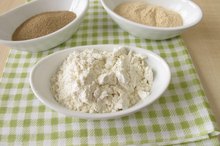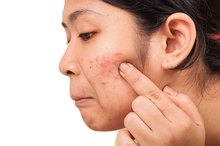What does fact checked mean?
At Healthfully, we strive to deliver objective content that is accurate and up-to-date. Our team periodically reviews articles in order to ensure content quality. The sources cited below consist of evidence from peer-reviewed journals, prominent medical organizations, academic associations, and government data.
The information contained on this site is for informational purposes only, and should not be used as a substitute for the advice of a professional health care provider. Please check with the appropriate physician regarding health questions and concerns. Although we strive to deliver accurate and up-to-date information, no guarantee to that effect is made.
Fiber's Effects on Acne
Acne has many different causes, which is why it can be so difficult to treat. Certain acne treatments can be too severe and further aggravate the skin. Adding fiber to a diet is a simple, natural way to lessen acne breakouts without all of the harsh side effects.
Types
According to the Mayo Clinic, there are five different types of acne: comedones, papules, nodules, cysts and pustles 1.cause:
- According to the Mayo Clinic
- there are five different types of acne: comedones
- papules
- nodules
- cysts
- pustles 1
Comedones--commonly referred to as blackheads or whiteheads--are the most common form and typically the easiest to treat. Nodules and cysts are often the most difficult forms of acne to treat because the infections run deep underneath the skin. Nodules are characterized by solid, often painful bumps. Cysts are similar to nodules, only they aren't solid but filled with pus.
- According to the Mayo Clinic, there are five different types of acne: comedones, papules, nodules, cysts and pustles 1.cause: * According to the Mayo Clinic
* there are five different types of acne: comedones
* papules
* nodules
* cysts
* pustles 1 Comedones--commonly referred to as blackheads or whiteheads--are the most common form and typically the easiest to treat.
Causes
Vaginal Acne
Learn More
Acne is caused by overactive oil glands, a buildup of bacteria, or a buildup of dead skin cells. However, many different factors are attributed to these problems. According to the Acne Resource Center Online, they include:
- hormones
- stress
- diet
- poor digestion
- chemicals in certain cosmetics
Adding fiber to a diet can eliminate two of these factors--the diet and poor digestion.
Diet
A study conducted at the Royal Melbourne Hospital and published in the American Journal of Clinical Nutrition found a link between refined or white carbohydrates and acne. Throughout the two-year study, researchers monitored glucose and insulin levels and their effects on the skin. They found that diets high in refined carbohydrates resulted in higher incidents of acne. Therefore, switching from white breads and pastas to high fiber, whole wheat brands can lessen the severity of acne.
- A study conducted at the Royal Melbourne Hospital and published in the American Journal of Clinical Nutrition found a link between refined or white carbohydrates and acne.
Digestion
Psyllium Husks & Acne
Learn More
The Acne Resource Center Online says that poor digestion makes it difficult for the body to absorb essential nutrients, and therefore it can’t fight acne-causing bacteria. Fiber promotes a healthy digestive system. It does this by slowing the absorption of certain nutrients in the bloodstream, which allows our body to utilize more nutrients from foods we eat. It also promotes regular bowel movements, which allow us to eliminate potentially harmful contaminants.
- The Acne Resource Center Online says that poor digestion makes it difficult for the body to absorb essential nutrients, and therefore it can’t fight acne-causing bacteria.
- It does this by slowing the absorption of certain nutrients in the bloodstream, which allows our body to utilize more nutrients from foods we eat.
Considerations
The Mayo Clinic recommends that males and females younger than 50 consume 38g and 25g of fiber per day, respectively 1. Males and females over 50 should strive for 30g and 21g, respectively. People who aren’t used to consuming this much fiber may notice initial stomach bloating and other discomforts. However, this will pass as the body becomes accustomed to the increased fiber.
- The Mayo Clinic recommends that males and females younger than 50 consume 38g and 25g of fiber per day, respectively 1.
Related Articles
References
- Mayo Clinic
- Whitney KM, Ditre CM. Management strategies for acne vulgaris. Clin Cosmet Investig Dermatol. 2011;4:41-53. doi:10.2147/CCID.S10817
- National Institute of Arthritis and Musculoskeletal and Skin Diseases. Living with acne. Updated September 2016.
- Zaenglein AL, Pathy AL, Schlosser BJ, et al. Guidelines of care for the management of acne vulgaris. J Am Acad Dermatol. 2016;74(5):945-73.e33. doi:10.1016/j.jaad.2015.12.037
- Rathi SK. Acne vulgaris treatment : the current scenario. Indian J Dermatol. 2011;56(1):7-13. doi:10.4103/0019-5154.77543
Writer Bio
Maria Price worked as an editor for a medical publishing company for several years. She now does freelance editing and writing for various companies both in and out of the medical field. Price has a Master of Science degree from Drexel University in publications management.









